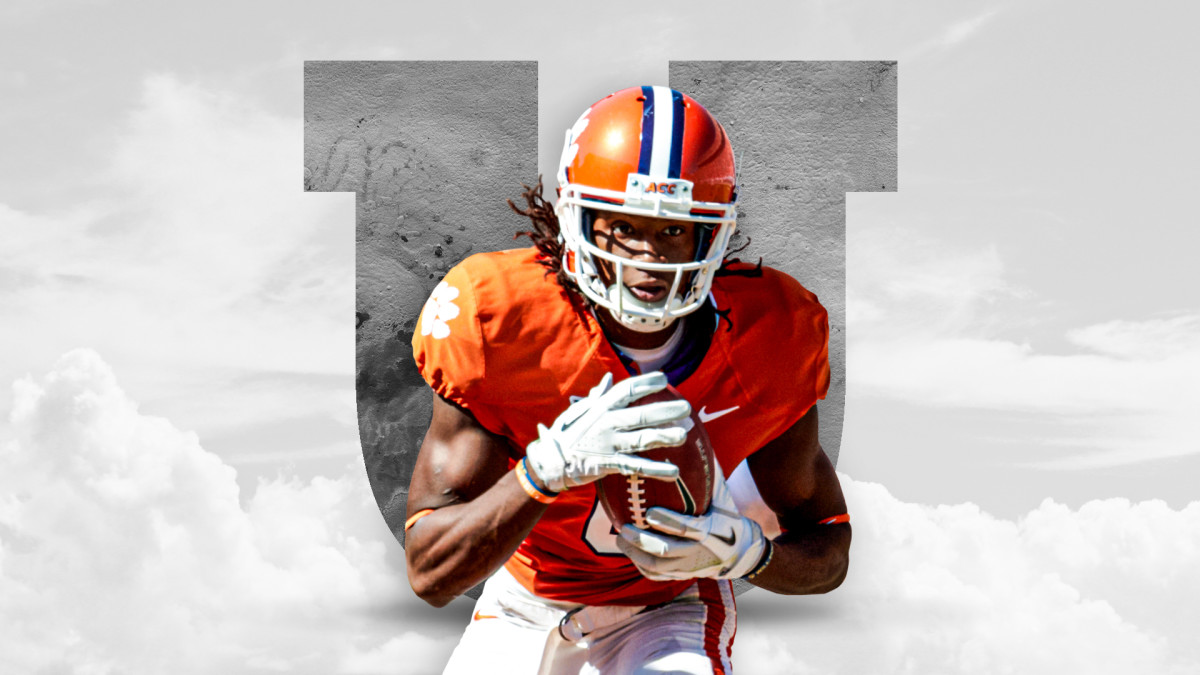Who Is the New Wide Receiver U.?
We determined each “Position U.” by measuring what every college should strive to do, in sports and beyond: Prepare students for professional careers. For the full explanation of our scoring system, scroll to the bottom of this article.
How prolific has Clemson been? Eleven of their receivers who entered the league between 2010 and ’19 started at least one game in the NFL. The Tigers are led by DeAndre Hopkins and his three All-Pro nods—only Central Michigan alum Antonio Brown has more.
Added up, it's enough to hold off a Michael Thomas–led Ohio State group, in large part because the Buckeyes didn’t have a single first-round pick in the 2010s (Devin Smith, 37th overall in 2015, was the highest selection).
Alabama has some headliners—Julio Jones, Amari Cooper and Calvin Ridley—but aside from that trio only had two other receivers drafted over the course of the decade (ArDarius Stewart and Kevin Norwood). There are reinforcements coming in the form of Jerry Jeudy and Henry Ruggs III, but they don't count toward this calculation.
* * *
WELCOME TO POSITION U.: Quarterback U. | Linebacker U. | Offensive Line U. | Running Back U. | Tight End U. | Defensive Line U. | Defensive Back U.
* * *
WIDE RECEIVER U.: CLEMSON

1. Clemson, 54 points
2. Ohio State, 46
3. LSU, 40
4. Alabama, 36
5. Georgia, 35
6(tie). Baylor, 33
6(tie). USC, 33
8. Notre Dame, 30
9(tie). Oklahoma, 27
9(tie). Tennessee, 27
* * *
ALUMNI FOR TOP THREE
CLEMSON ALUMNI
DeAndre Hopkins (2013 first round, 110 starts, 3x All-Pro)
Sammy Watkins (2014 4th overall, 73 starts)
Mike Williams (2017 7th overall, 21 starts)
Martavis Bryant (2014 fourth round, 18 starts)
Jaron Brown (2013 undrafted, 19 starts)
Deon Cain (2018 sixth round, 6 starts)
Jacoby Ford (2010 fourth round, 13 starts)
Adam Humphries (2015 undrafted, 20 starts)
Ray-Ray McCloud III (2018 sixth round, 1 start)
Charone Peake (2016 seventh round, 1 start)
Hunter Renfrow (2019 fifth round, 4 starts)
OHIO STATE ALUMNI
Michael Thomas (2016 second round, 57 starts, 2x All-Pro, OPOY)
Curtis Samuel (2017 second round, 27 starts)
Terry McLaurin (2019 third round, 14 starts)
Braxton Miller (2016 third round, 9 starts)
Philly Brown (2014 undrafted, 22 starts)
Parris Campbell (2019 second round, 3 starts)
DeVier Posey (2012 third round, 1 start)
Devin Smith (2015 second round, 5 starts)
Noah Brown (2017 seventh round, 3 starts)
Jalin Marshall (2016 undrafted, 1 start)
Dane Sanzenbacher (2011 undrafted, 3 starts)
Evan Spencer (2015 sixth round)
LSU ALUMNI
Odell Beckham Jr. (2014 first round, 71 starts, OROY)
Brandon LaFell (2010 third round, 90 starts)
Jarvis Landry (2014 second round, 87 starts)
Rueben Randle (2012 second round, 33 starts)
D.J. Chark (2018 second round, 14 starts)
Russell Gage (2018 sixth round, 4 starts)
Russell Shepard (2013 undrafted, 9 starts)
James Wright (2014 seventh round, 2 starts)
Malachi Dupre (2017 seventh round)
Trindon Holliday (2010 sixth round)
Kadron Boone (2014 undrafted)
Cyril Grayson (2017 undrafted)
* * *
OUR SCORING SYSTEM
In order to make it modern, we used a 10-year data set. Dipping further back would mean going across different coaching eras at the college level, as well as including a lot of players who are no longer active in the NFL. (We did run an unofficial 20-year data set for the quarterback position, which you can read about at the bottom of this article.)
We came up with a scoring system that balanced not just the quantity of players programs put into the NFL, but the quality of those players' careers. One measure we used is draft position—an inexact but still relevant measure of a player's approximate value when he left college. We credited players for career games started. But rather than assigning a point value to every game started, which would weigh too heavily in favor of older players, we lessened that effect by using ranges.
We also awarded points for the highest achievements (MVP, and for non-quarterbacks, Offensive/Defensive Player of the Year and All-Pro) and awarded a smaller amount of credit for Rookie of the Year, an indication of a player's preparedness when entering the league. (We made the decision to exclude the Pro Bowl. Between fan voting and the league's need to dig deep into the pool of alternates with so many players dropping out annually, there's been a reduction in the legitimacy of that achievement.)
For all positions in this series, scoring is based on alumni who entered the NFL between 2010 and 2019 and were either (1) drafted or (2) undrafted but appeared in at least one game. Players who transferred during their college careers are counted only as part of the last program they played for. Players are only credited for the position at which they were drafted. Our full scoring system:
DRAFT POSITION
Top 10: 4 points
Round 1 (non-top 10): 3 points
Rounds 2-3: 2 points
Rounds 4-7: 1 point
Undrafted: 0 points
NFL GAMES STARTED
80-plus: 5 points
48 to 79: 4 points
16 to 47: 3 points
5 to 15: 2 points
1 to 4: 1 point
NFL AWARDS
Offensive Player of the Year: 4 points
First-Team All-Pro: 3 points
Offensive Rookie of the Year: 2 points
Research by Reid Foster and Gary Gramling.
• Question or comment? Email us.
